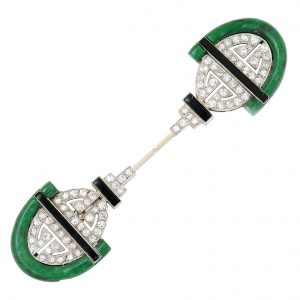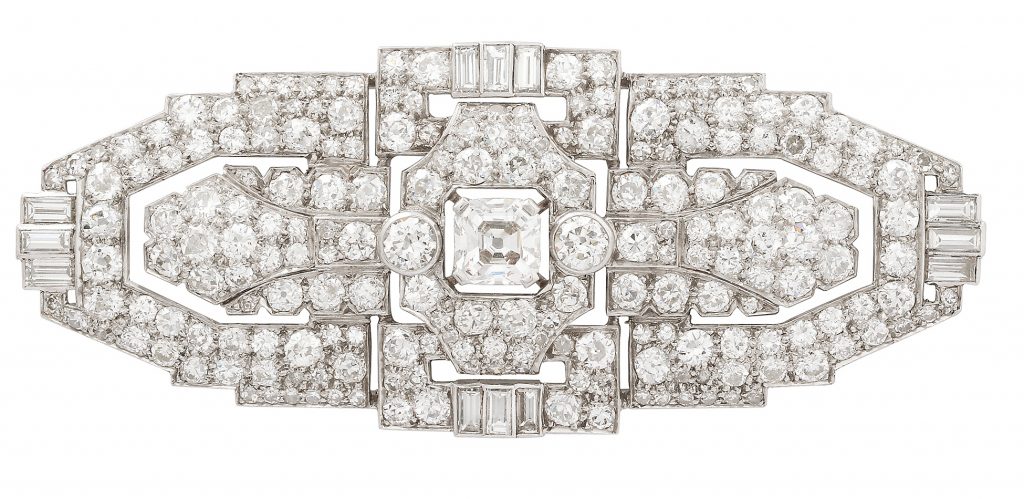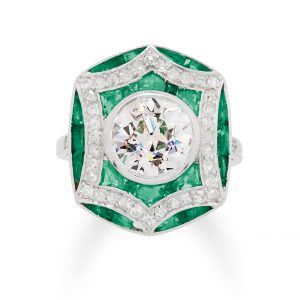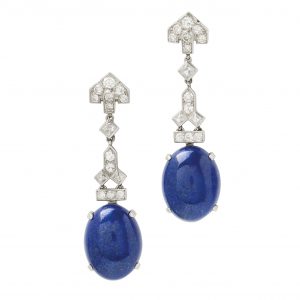If you think of the high-spirited, high society Roaring Twenties, then fun, fashion and frolic might come to mind. It was the birth of the Art Deco era with its heightened predisposition to notorious and extravagant glamour. Daring designs emerged, most especially in jeweller that continues to be popular today.

Lot 74 An Art Deco Jadeite, Onyx, Diamond and Platinum Jabot Pin, by Lacloche Frères
The Art Deco era occurred in the midst of a prosperous Post-war economy, Thriving industries, including those dealing in precious jewellery, were actively and enthusiastically supported by the gentry. Times and morés were changing and such strictures, particularly for women, were beginning to relax, leading to a new sense of freedom and the power to express their individuality through their accessories. Those so inclined were able to lavish money, or more likely their husband’s money, on luxuries like fine jewels. Advancements in materials and methods allowed designers to take new risks in design.
The period is mainly considered to span from the 1920s to the 1930s, and was popularized at the hugely important exhibit of designers and manufacturers invited to show the world their latest and greatest innovations in Paris in 1925. The scope of the new look was vast and influenced not just jewellery but everything from fine art, to household items and architecture: picture the silhouettes of New York’s landmark Chrysler and Empire State buildings. Subsequently, the term Art Deco was coined only in the 1960s to categorize the overall style and the name is credited to Art historian Bevis Hillier who derived it from that highly significant 1925 gathering, the Exposition Internationale des Arts Decoratifs et Industriels Moderne.

Lot 296 An Art Deco Diamond and Platinum Brooch, circa 1930.

Lot 290 An Art Deco Diamond, Emerald and Platinum Ring, circa 1920
Signature design elements include precisely defined angles, regimented linear qualities and a more industrial feel via pleasingly repetitive and symmetrical patterns. Bold shapes and strong grid-like lines and tiered stepped edges are the calling cards of Art Deco. Look for rectangles, triangles, circles and squares. Mitre-shaped terminals are also indicative of popular motifs, whether singly or as part of convertible double-clip brooches.
Look for round old European-cuts which overlap in time and evolve into the scintillating transitional-cut. The elegant squared, Asscher-cuts are obviously evocative of the era and are still surprisingly modern looking. Commonly, smaller accent diamonds are baguette, bullet-cut and shield-shaped.

Lot 222 An Art Deco Pair of Lapis Lazuli, Diamond and Platinum Ear Pendants, by Cartier
White metals were in vogue during the Art Deco era, especially platinum, while white gold was considered a popular substitute and a more affordable alternative with a similar look.
Art Deco pieces often get their bright colours from rubies, emeralds and sapphires, sometimes seen in Tutti-Frutti carved leaves or what’s known as calibré-cut, rows of very small multiple gems that are customized to fit narrow specialty channels and uniformly spaced tightly together rather than individually amid visible claw settings. Jade, black onyx, coral, rock crystal and lapis lazuli effectively create harmonious combinations of striking contrast when paired with diamonds.
Art Deco retains its influence with a unique ability to channel vintage elegance while still evoking a contemporary feel. This universal modern appeal widens its desirability among fashion enthusiasts. If you’re craving a genuine statement piece to reflect your personal style, consider the timeless allure of Art Deco jewellery.
Dupuis Fine Jewellery Auctioneers offers several unique and hard-to-find pieces sure to speak to your inner flapper:

Considering selling a single item or a large estate? Our highly qualified specialists and friendly staff have years of experience evaluating, pricing and marketing to bring your jewels to the global auction market.
If you are thinking of adding to your collection, Dupuis’ auctions provide a unique opportunity to purchase rare and one-of-a-kind antique and modern jewellery.
Browse auction calendar to view upcoming auction and event.
View Auction CalendarGuide to BuyingGuide to Selling